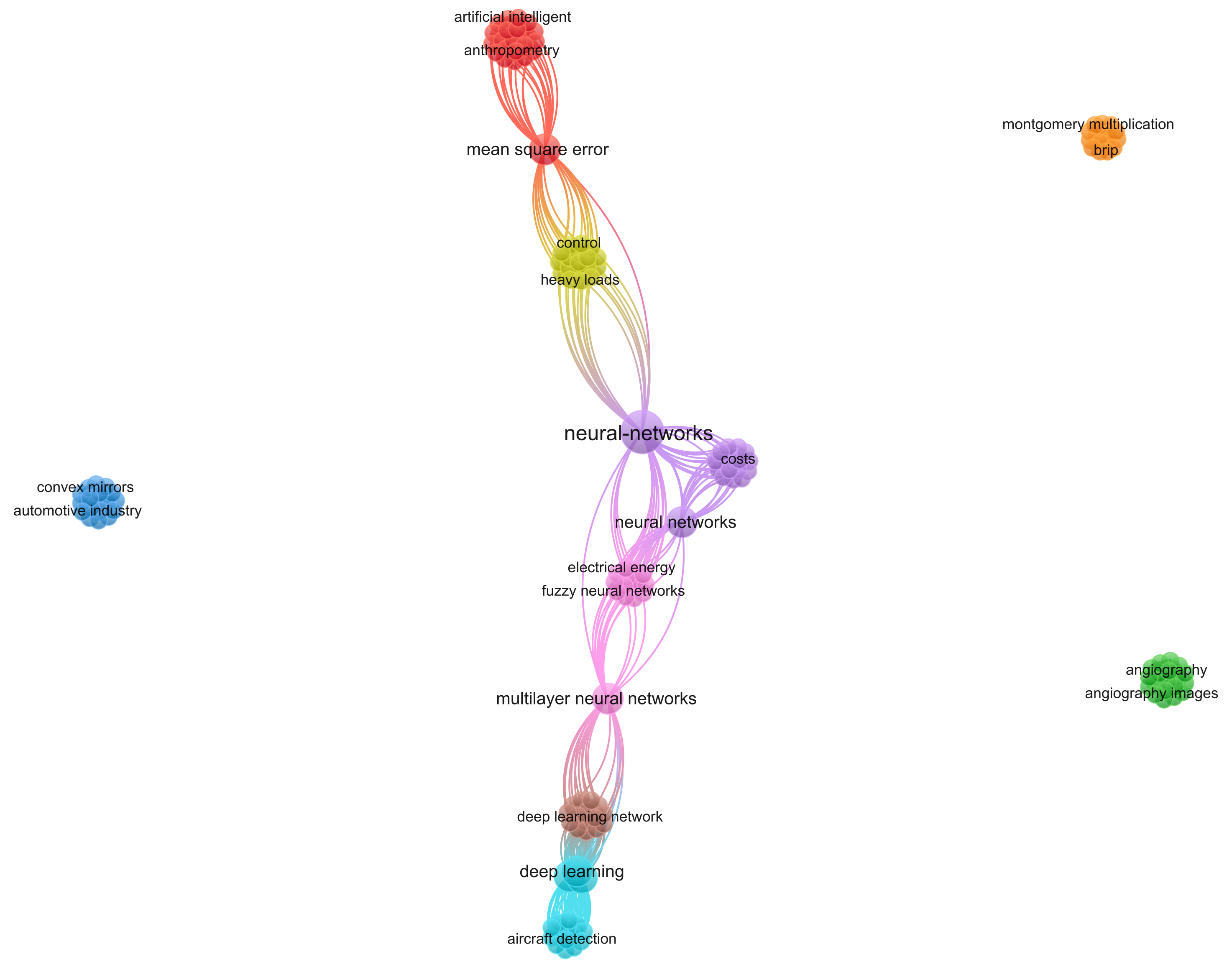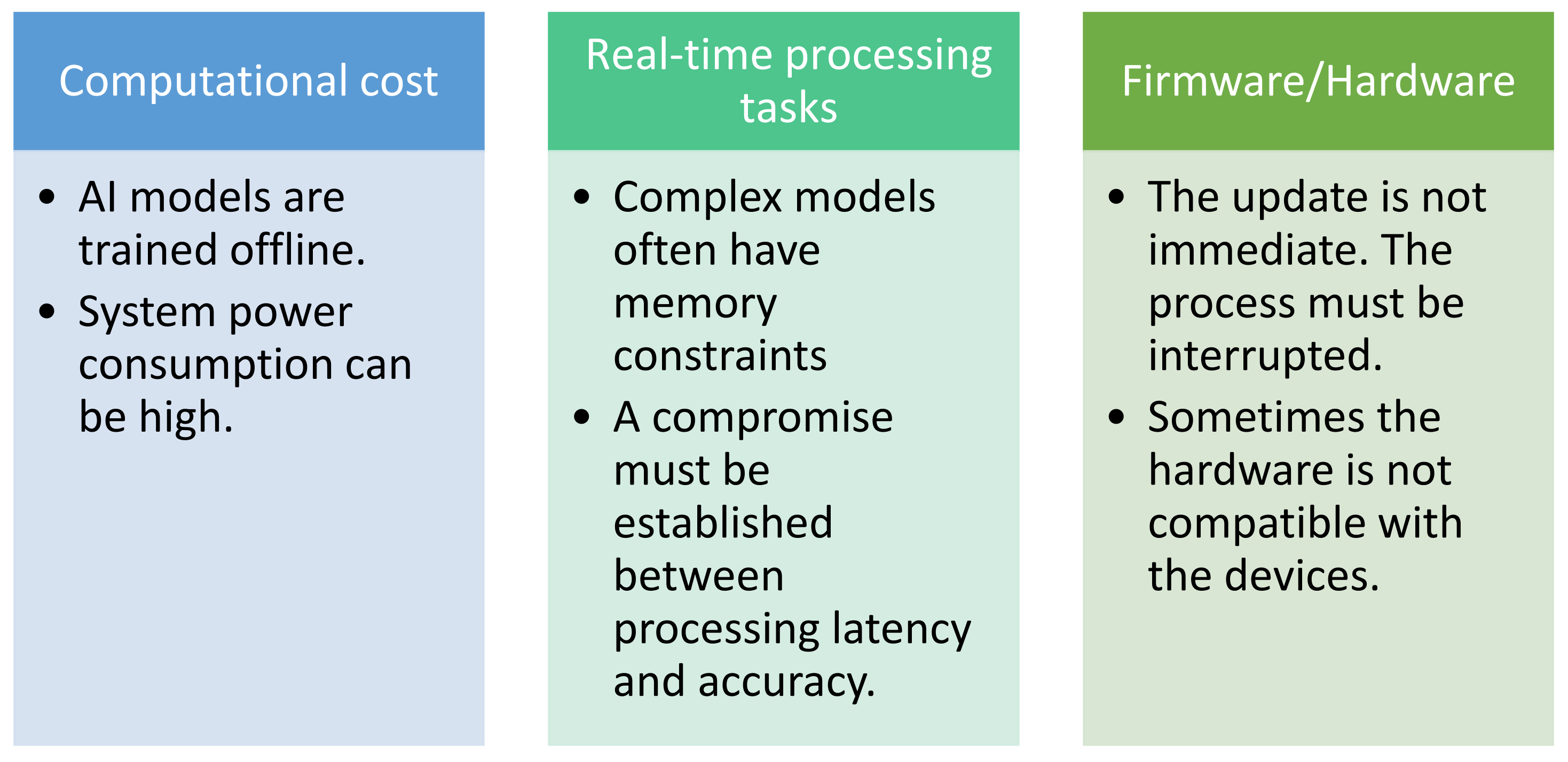The Integration of Artificial Intelligence with Micro–Nano-Systems: Perspectives, Challenges and Future Prospects
Author Contributions
Funding
Institutional Review Board Statement
Data Availability Statement
Conflicts of Interest
References
- Zhang, Z.; Li, J. A review of artificial intelligence in embedded systems. Micromachines 2023, 14, 897. [Google Scholar] [CrossRef] [PubMed]
- Ghanbarzadeh-Dagheyan, A.; Jalili, N.; Ahmadian, M.T. A holistic survey on mechatronic Systems in Micro/Nano scale with challenges and applications. J. Micro-Bio Robot. 2021, 17, 1–22. [Google Scholar] [CrossRef]
- Shi, Z.; Zhang, Y.; Gu, J.; Liu, B.; Fu, H.; Liang, H.; Ji, J. Triboelectric nanogenerators: State of the art. Sensors 2024, 24, 4298. [Google Scholar] [CrossRef] [PubMed]
- Asamoah, G.A.; Korsah, M.; Jeyasundar, P.G.S.A.; Ahmed, M.; Lau, S.Y.; Danquah, M.K. Nanotechnology-based lithium-ion battery energy storage systems. Sustainability 2024, 16, 9231. [Google Scholar] [CrossRef]
- Bae, J. Applications of nanomaterials and nanotechnology in energy storage device. Nanomaterials 2022, 12, 4353. [Google Scholar] [CrossRef]
- Xiao, J.; Guo, H.; Zhou, J.; Zhao, T.; Yu, Q.; Chen, Y.; Wang, Z. Tiny object detection with context enhancement and feature purification. Expert Syst. Appl. 2023, 211, 118665. [Google Scholar] [CrossRef]
- Khan, M.A.; Menouar, H.; Eldeeb, A.; Abu-Dayya, A.; Salim, F.D. On the detection of unauthorized drones—Techniques and future perspectives: A review. IEEE Sensors J. 2022, 22, 11439–11455. [Google Scholar] [CrossRef]
- Manickam, P.; Mariappan, S.A.; Murugesan, S.M.; Hansda, S.; Kaushik, A.; Shinde, R.; Thipperudraswamy, S.P. Artificial intelligence (AI) and Internet of Medical Things (IoMT) assisted biomedical systems for intelligent healthcare. Biosensors 2022, 12, 562. [Google Scholar] [CrossRef]
- Dong, H.; Lin, J.; Tao, Y.; Jia, Y.; Sun, L.; Li, W.J.; Sun, H. AI-enhanced biomedical micro/nanorobots in microfluidics. Lab Chip 2024, 24, 1419–1440. [Google Scholar] [CrossRef]
- Kasture, K.; Shende, P. Amalgamation of artificial intelligence with nanoscience for biomedical applications. Arch. Comput. Methods Eng. 2023, 30, 4667–4685. [Google Scholar] [CrossRef]
- Kozłowski, M.; Racewicz, S.; Wierzbicki, S. Image analysis in autonomous vehicles: A review of the latest AI solutions and their comparison. Appl. Sci. 2024, 14, 8150. [Google Scholar] [CrossRef]
- Pooyandeh, M.; Sohn, I. Smart lithium-ion battery monitoring in electric vehicles: An AI-empowered digital twin approach. Mathematics 2023, 11, 4865. [Google Scholar] [CrossRef]
- Czerwinski, F. Current trends in automotive lightweighting strategies and materials. Materials 2021, 14, 6631. [Google Scholar] [CrossRef] [PubMed]
- Mujkić, A.; Baralić, E.; Ombašić, A.; Bećirović, L.S.; Pokvić, L.G.; Badnjević, A. Machine intelligence in biomedical data modeling, processing, and analysis. In Proceedings of the 2022 11th Mediterranean Conference on Embedded Computing (MECO), Budva, Montenegro, 7–10 June 2022; IEEE: Piscataway, NJ, USA, 2022; pp. 1–10. [Google Scholar]
- Xu, H. Intelligent automobile auxiliary propagation system based on speech recognition and AI driven feature extraction techniques. Int. J. Speech Technol. 2022, 25, 893–905. [Google Scholar] [CrossRef]
- Deng, M.; Chen, J.; Wu, Y.; Ma, S.; Li, H.; Yang, Z.; Shen, Y. Using voice recognition to measure trust during interactions with automated vehicles. Appl. Ergon. 2024, 116, 104184. [Google Scholar] [CrossRef]
- Clark, J.R.; Large, D.R.; Shaw, E.; Nichele, E.; Trigo, M.J.G.; Fischer, J.E.; Burnett, G.; Stanton, N.A. Identifying interaction types and functionality for automated vehicle virtual assistants: An exploratory study using speech acts cluster analysis. Appl. Ergon. 2024, 114, 104152. [Google Scholar] [CrossRef]
- Rovira-Sugranes, A.; Razi, A.; Afghah, F.; Chakareski, J. A review of AI-enabled routing protocols for UAV networks: Trends, challenges, and future outlook. Ad Hoc Netw. 2022, 130, 102790. [Google Scholar] [CrossRef]
- Wijesundara, D.; Gunawardena, L.; Premachandra, C. Human Recognition from High-altitude UAV Camera Images by AI based Body Region Detection. In Proceedings of the 2022 Joint 12th International Conference on Soft Computing and Intelligent Systems and 23rd International Symposium on Advanced Intelligent Systems (SCIS&ISIS), Ise-Shima, Japan, 29 November–2 December 2022; IEEE: Piscataway, NJ, USA, 2022; pp. 1–4. [Google Scholar]
- Naresh, V.S.; Ratnakara Rao, G.V.; Prabhakar, D. Predictive machine learning in optimizing the performance of electric vehicle batteries: Techniques, challenges, and solutions. In Wiley Interdisciplinary Reviews: Data Mining and Knowledge Discovery; Wiley: Hoboken, NJ, USA, 2024; p. e1539. [Google Scholar]
- Jain, M.; Vasdev, D.; Pal, K.; Sharma, V. Systematic literature review on predictive maintenance of vehicles and diagnosis of vehicle’s health using machine learning techniques. Comput. Intell. 2022, 38, 1990–2008. [Google Scholar] [CrossRef]
- Villegas-Mier, C.G.; Rodriguez-Resendiz, J.; Álvarez-Alvarado, J.M.; Rodriguez-Resendiz, H.; Herrera-Navarro, A.M.; Rodríguez-Abreo, O. Artificial neural networks in MPPT algorithms for optimization of photovoltaic power systems: A review. Micromachines 2021, 12, 1260. [Google Scholar] [CrossRef]
- Paredes-Orta, C.; Valentin-Coronado, L.M.; Díaz-Ponce, A.; Rodríguez-Reséndiz, J.; Mendiola-Santibañez, J.D. Distortion calculation method based on image processing for automobile lateral mirrors. Micromachines 2022, 13, 401. [Google Scholar] [CrossRef]
- Hernandez-Alvarado, R.; Rodriguez-Abreo, O.; Garcia-Guendulain, J.M.; Hernandez-Diaz, T. Self-Tuning Control Using an Online-Trained Neural Network to Position a Linear Actuator. Micromachines 2022, 13, 696. [Google Scholar] [CrossRef] [PubMed]
- Quintana-Quintana, O.J.; De León-Cuevas, A.; González-Gutiérrez, A.; Gorrostieta-Hurtado, E.; Tovar-Arriaga, S. Dual U-Net-based conditional generative adversarial network for blood vessel segmentation with reduced cerebral MR training volumes. Micromachines 2022, 13, 823. [Google Scholar] [CrossRef] [PubMed]
- Tinoco-Varela, D.; Ferrer-Varela, J.A.; Cruz-Morales, R.D.; Padilla-García, E.A. Design and Implementation of a Prosthesis System Controlled by Electromyographic Signals Means, Characterized with Artificial Neural Networks. Micromachines 2022, 13, 1681. [Google Scholar] [CrossRef] [PubMed]
- Camacho-Pérez, E.; Chay-Canul, A.J.; Garcia-Guendulain, J.M.; Rodríguez-Abreo, O. Towards the Estimation of Body Weight in Sheep Using Metaheuristic Algorithms from Biometric Parameters in Microsystems. Micromachines 2022, 13, 1325. [Google Scholar] [CrossRef] [PubMed]
- Morales Romero, J.d.J.; Reyes Barranca, M.A.; Tinoco Varela, D.; Flores Nava, L.M.; Espinosa Garcia, E.R. SCA-Safe Implementation of Modified SaMAL2R Algorithm in FPGA. Micromachines 2022, 13, 1872. [Google Scholar] [CrossRef]
- Zhang, X.; Fan, K.; Hou, H.; Liu, C. Real-time detection of drones using channel and layer pruning, based on the yolov3-spp3 deep learning algorithm. Micromachines 2022, 13, 2199. [Google Scholar] [CrossRef]
- Ren, Z.; Ren, G.; Wu, D. Deep learning based feature selection algorithm for small targets based on mRMR. Micromachines 2022, 13, 1765. [Google Scholar] [CrossRef]


Disclaimer/Publisher’s Note: The statements, opinions and data contained in all publications are solely those of the individual author(s) and contributor(s) and not of MDPI and/or the editor(s). MDPI and/or the editor(s) disclaim responsibility for any injury to people or property resulting from any ideas, methods, instructions or products referred to in the content. |
© 2025 by the authors. Licensee MDPI, Basel, Switzerland. This article is an open access article distributed under the terms and conditions of the Creative Commons Attribution (CC BY) license (https://creativecommons.org/licenses/by/4.0/).
Share and Cite
Rodríguez-Reséndiz, J.; Aviles, M.; Álvarez-Alvarado, J.M. The Integration of Artificial Intelligence with Micro–Nano-Systems: Perspectives, Challenges and Future Prospects. Micromachines 2025, 16, 301. https://doi.org/10.3390/mi16030301
Rodríguez-Reséndiz J, Aviles M, Álvarez-Alvarado JM. The Integration of Artificial Intelligence with Micro–Nano-Systems: Perspectives, Challenges and Future Prospects. Micromachines. 2025; 16(3):301. https://doi.org/10.3390/mi16030301
Chicago/Turabian StyleRodríguez-Reséndiz, Juvenal, Marcos Aviles, and José M. Álvarez-Alvarado. 2025. "The Integration of Artificial Intelligence with Micro–Nano-Systems: Perspectives, Challenges and Future Prospects" Micromachines 16, no. 3: 301. https://doi.org/10.3390/mi16030301
APA StyleRodríguez-Reséndiz, J., Aviles, M., & Álvarez-Alvarado, J. M. (2025). The Integration of Artificial Intelligence with Micro–Nano-Systems: Perspectives, Challenges and Future Prospects. Micromachines, 16(3), 301. https://doi.org/10.3390/mi16030301






